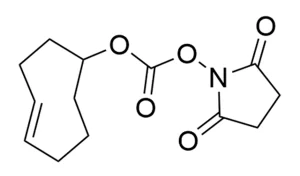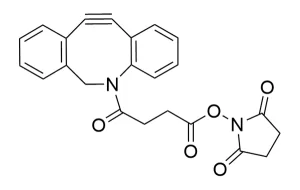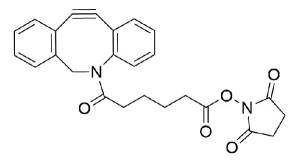Phthalimidooxy-dPEG®12-NHS ester, product number QBD-10011, is a protected aminooxy compound linked to an amine-reactive N-hydroxysuccinimidyl (NHS) ester through a medium-length (41 atoms, 46.3 Å), single molecular weight, discrete polyethylene glycol (dPEG®) spacer. This allows a hydrophilic, protected aminooxy group to be installed on peptides, proteins, small molecules, and amine-functionalized surfaces.
The phthaloyl moiety on phthalimidooxy-dPEG®4-NHS ester stably protects the aminooxy group. Following amide bond formation, the phthalimide group can be removed using aqueous hydrazine or hydroxylamine, leaving the aminooxy group free to react. Oxime bonds form from the reaction between an aminooxy group and an aldehyde (creating an aldoxime bond) or ketone (creating a ketoxime bond). Compared to hydrazone bonds, oxime bonds are exceptionally stable. They do not break under physiological or even slightly acidic conditions that can occur under some physiological states.
The amine-reactive NHS ester has optimal reactivity in the pH range of 7.0 – 7.4. This group should be reacted first as the subsequent deprotection step for the aminooxy group will also react with the NHS ester.
| Unit Size | 100mg, 1000mg |
|---|---|
| Molecular Weight | 860.90; single compound |
| Chemical formula | C₃₉H₆₀N₂O₁₉ |
| CAS | N/A |
| Purity | > 97% |
| Spacers | dPEG® Spacer is 41 atoms and 46.3 Å |
| Shipping | Ambient |
| Typical solubility properties (for additional information contact Customer Support) | Methylene chloride or Acetonitrile. |
| Storage and handling | -20°C; Always let come to room temperature before opening; be careful to limit exposure to moisture and restore under an inert atmosphere; stock solutions can be prepared with dry solvent and kept for several days (freeze when not in use). dPEG® pegylation compounds are generally hygroscopic and should be treated as such. This will be less noticeable with liquids, but the solids will become tacky and difficult to manipulate, if care is not taken to minimize air exposure. |
Greg T. Hermanson, Bioconjugate Techniques, 3rd Edition, Elsevier, Waltham, MA 02451, 2013, ISBN 978-0-12-382239-0; See Chapter 18, Discrete PEG Reagents, pp. 787-821, for a full overview of the dPEG® products.
Applicable patents and legal notices are available at legal notices.




Stay in the Loop. Join Our Online Community
Products
Ordering
About Us
Application
Resources

©Vector Laboratories, Inc. 2025 All Rights Reserved.
To provide the best experiences, we use technologies like cookies to store and/or access device information. Consenting to these technologies will allow us to process data such as browsing behavior or unique IDs on this site. Not consenting or withdrawing consent, may adversely affect certain features and functions. Privacy Statement
How do I Request a Quote?
To request a quote for products: